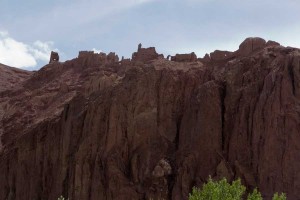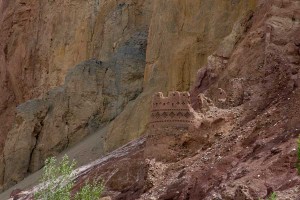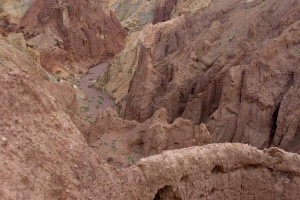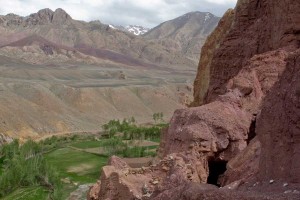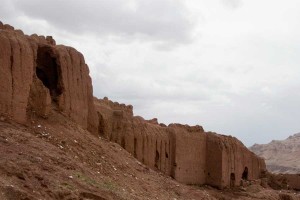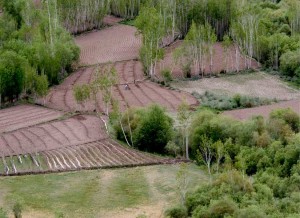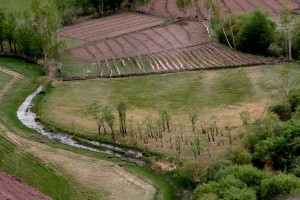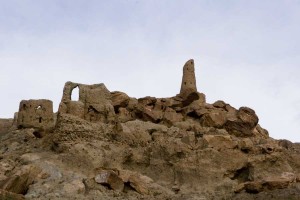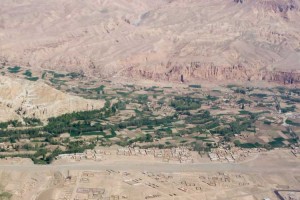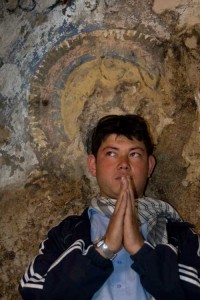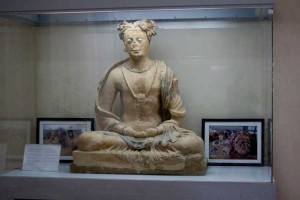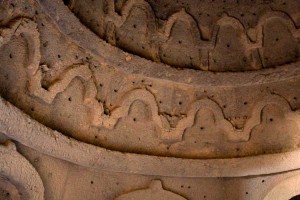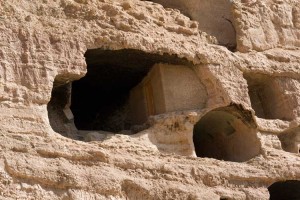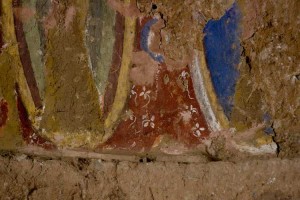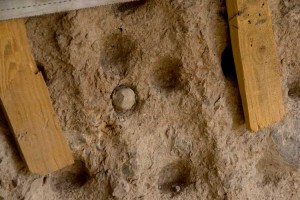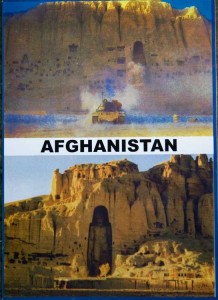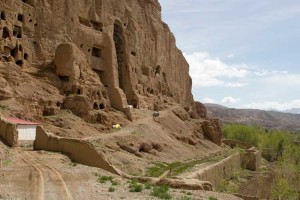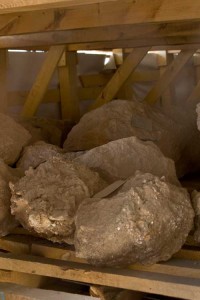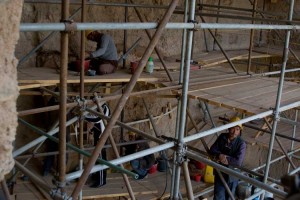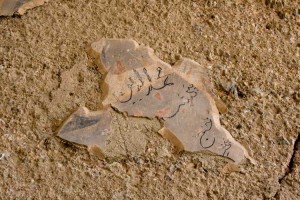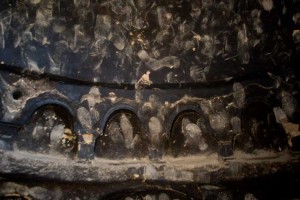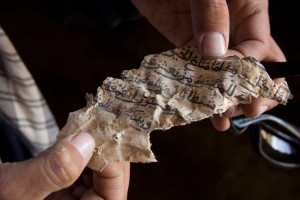archeology
Bamiyan Province, Part 3
Saturday, July 17th, 2010
About 15km east of Bamiyan along the Silk Road lie the ruins of the ancient city of Zohak. Made entirely of red-mud bricks, it is also known as The Red City. Sitting atop a 350′ cliff of of red rocks overlooking the confluence of the Bamiyan and Kalu rivers, it guards the Eastern entrance of the long narrow Bamiyan Valley.
One would think that just being up so high would be defense enough, but in addition along the steep path were various guard towers and finally a tunnel one must pass through to reach the top.
Although the present remains were built in the 12th century by the Shansabani Kings, there is also evidence that during the time of the Hephthalite Huns in the 6th century, there was already a massive complex here. In fact, I saw pottery shards from the Kushan Dynasty period, which was dominant in this area during the 1st-4th centuries. In modern times, it became a Mujahidin stronghold during the war against the Soviets. At its peak, 3000 people resided here.
The story of how the city got its name was best told by Nancy Hatch Dupree:
“Zohak first appears in the Shahnama as a noble prince of Arabia, a devoted son well-beloved by his people. He became, however, possessed of the Devil who induced him to usurp his father’s throne whereupon the Devil appeared disguised as a loyal subject who asked to kiss the new king on the shoulders in token of his complete submission. No sooner had he done so, and vanished, than two black serpents thrust their heads out from where the kisses had been placed. Attempts to cut them off only resulted in their immediate return and their increased demand for human brains, the only food they would accept.
At the same time that Zohak was being seduced by the Devil, civil war broke out in Iran and Zohak marched in as the champion of one faction and was enthroned as the emperor of Iran. For a thousand years his rule brought terror and chaos to the land, but then the hero Fraidun was born. After many escapades, Fraidun finally succeeded in taking Zohak prisoner whereupon he took the dragon-king to a far off mountain peak and left him there to die. The Shahnama ends the tale here but, typically, Afghan legend goes on to elaborate by saying that, deprived of their daily meal of brains, the serpents turned on Zohak, bit into his scalp and fed upon his brains until he died.”
My guide told me that people believe that this city with its fertile valleys was the royal abode of Zohak.
I’ve read that in 1222, Genghis Khan sent his favorite grandson to deal with the Shansabani kings who responded by slaying the young general. As revenge, Genghis sent his warriors to storm the citadels. Every living thing in the valley was slaughtered. My guide told me that this actually happened in Gogola, The City of Screams which overlooks the Buddha site in Bamiyan.
Posted in Afghan Women's Project, archeology, AWP 2010, environment, Other | 1 Comment »
Bamiyan Part 2
Friday, June 4th, 2010
[Sorry to take so long to get this post up. Now I’m back in Austin and beginning to go through my interviews and photos. It’s a mountainous task! I will continue to write as I go through this process.]
Bamiyan means “shining place”. It’s holy for Zorastrians as well as Buddhists.
The cliff with the “Buddha caves” dominates the landscape of Bamiyan City. It runs along the ancient Silk Road between the the Hindu Kush and the “Baba Mountains”.
Abbas, a well-versed guide from the Agha Khan Foundation cultural Center, showed me around.
Bamiyan was chosen by the Hephthalites as the place to settle because of the mountain barriers and strategic defense points overlooking the valley, it’s location along the Silk Road and the conglomerate cliffs that could be easily carved into housing.
The worst war (of the Soviet, civil and Taliban) was the one with the Taliban. There wasn’t so much fighting during the “Russian times”. The Soviet army perched on the few high places and easily controlled the area but mostly, people were allowed to live their lives. The Taliban period was quite bloody, however, as here the conflict included racial animosity (Hazara vs. Pashtun) as well as a fight between the Sunni Taliban and the (to them) heretical Shia. Hazara fighters holed up in the caves, which had inner passages from one to the other. 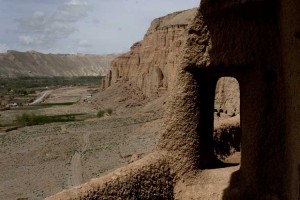 In some areas, water was also channeled inside. During and after the wars, 3000 or so families were living in the caves which kept them cool in the summer and relatively warm in the 6 months of harsh winter.
In some areas, water was also channeled inside. During and after the wars, 3000 or so families were living in the caves which kept them cool in the summer and relatively warm in the 6 months of harsh winter.
I was surprised to find that all of the 12,000 caves in the Bamiyan area are man made, the ones along the “Buddha cliff” hand dug at first by the Buddhist monks, and later by regular people to make their houses. Buddhists begain moving into the area in the second century and by the 5th century, 2,000 monks resided there
It took a full century to carve the Buddhas. The large one was covered with gold and diamonds and both were painted. They found heads of small Buddhas and small stupas below the wall with the Buddhas.
This excavation progresses in June and July when Professor Tarzai is free from his teaching duties. When he’s not there, the site is lined with plastic and filled in with dirt. 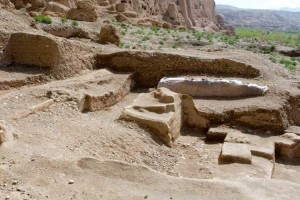
In Greece and Rome they found copies of a map of Bamiyan. It mixes Greek, Indian, Byzantine, Iranian Sasanid and Chinese architecture. It was made at the same time, using the different styles.
In this place with doors locked by UNESCO, the paintings are even better. The blue color was made of ground up lapis lazuli stones. The green was colored by a tree, yellow from herbs, and poppies made the red. These colors were mixed with either walnut or poppy seed oil. These date from the 5th to the 9th centuries, before oil painting was done in Europe.
Most of the Buddhas statues were just carved out of the soft stone cliff, but parts of them were modeled using a plaster of mud mixed with straw. The arms, which were also added, were secured in place with these
pock marks” which allowed the mud-glue and wooden pegs to adhere to the sides of the grotto.
The Taliban had a hard time destroying the Buddhas. First they shot at it, and when that didn’t work, they used dynamite. They blew charges three times a day. It took 1 week to destroy the small Buddha which was made of softer material and it took a month to destroy the large one.
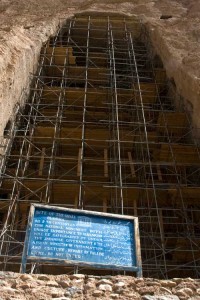
Once the Buddhas had been blown up, a lot of the rubble has now returned to dirt.
The plans are to do a partly fragmented reconstruction.
Here they are stabilizing the rocks. In this phase of the reconstruction, they are painting the rocks with chemicals to help solidify them.
In addition to destroying the Buddhas, the Mujahadin and Taliban also added their graffiti to the paintings
and had fun in the kitchen putting footprints on the ceiling.
As we were walking through the caves, Abbas found this crumpled handwritten piece of the Koran stuffed in a crack in the wall. We stopped at the tourism dept. on the way out to turn it in. They don’t know the exact date yet, but it may be several hundred years old.
Posted in Afghan Women's Project, archeology, environment, Other, tourism | Comments Off on Bamiyan Part 2
